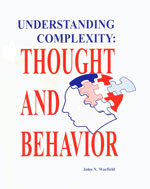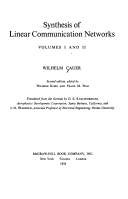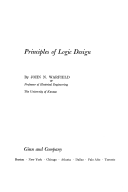{pagebuilderck 2}
UNDERSTANDING COMPLEXITY: THOUGHT AND BEHAVIOR


Integrating the material in several earlier books, this book explains how complexity can be resolved by the use of processes that are designed in the full light of two sets of scientific literature:
The literature on formal logic: (Aristotle, Abelard, De Morgan, Boole, Peirce, Harary, Warfield)
The literature on behavioral pathologies of individual, groups, and organizations: (Alberts, Allison, Argyris, Bales, Boulding, Cardenas, Downs, Foucault, Janis, Lasswell, Miller, Simon, Tuckman, Warfield)
The book shows how processes that incorporate the research results from these two literatures have been applied repeatedly in government, industry, religion, and universities to resolve complexity. Specific instances of successful applications of Systems Science are described in detail.
The concept of complexity is interpreted comprehensively. Various metrics of complexity are defined, modes of computing their values are given and values from applications are shown. Dr Warfield presents the Twenty Laws of Complexity that he has compiled, explaining their use in organizations. Warfield explains how commonly-made assumptions prevent resolution of complexity. The book contains numerous drawings and tables and provides a detailed index.
Please visit the Book Store for more information on how to purchase this book.
THE MATHEMATICS OF STRUCTURE


In Warfield's 1976 book titled Societal Systems: Planning, Policy, and Complexity, published by Wiley Interscience Systems Engineering Series (Harold Chestnut, Editor), he presented an integrated sequence of chapters on what he has since labeled as "the mathematics of structure". It was in this book that he introduced a computer-assisted group process called "Interpretive Structural Modeling."
The mathematics that provided the basis of concepts presented in Societal Systems were inadvertently camouflaged by residing within the larger text; therefore, Warfield decided to extract this information and publish The Mathematics of Structure as a separate text in the year 2003.
Chapter titles:
- Boolean Algebra, Sets, and Binary Relations
- Binary Matrices and Matrix Models
- Digraphs, Digraph Maps, and Digraph Models
- Structure and Complexity
- Cycles
- Interpretive Structural Modeling (ISM)
Within the first three chapters, this book offers the foundational mathematics of structure.
The last three chapters show how computer-assisted model construction can assist in taking advantage of the aggregated and integrated beliefs of well-informed (and partially-informed) groups of actors (meaning individuals taking action).
The middle chapter, "Structure and Complexity," explains how applications of the mathematics of structure enable insights to be developed about problematic situations - insights that will not be discovered using methods that are less scientific.
Please visit the Book Store for more information on how to purchase this book.
AN INTRODUCTION TO SYSTEMS SCIENCE


A HANDBOOK OF INTERACTIVE MANAGEMENT

 With minor exceptions, this collection of PDFs contains the material in the second edition of the following book:
With minor exceptions, this collection of PDFs contains the material in the second edition of the following book:
J.N. Warfield and A.R. Cardenas (1994), A HANDBOOK OF INTERACTIVE MANAGEMENT, 2ND Ed., Ames, IA: The Iowa State University Press (ISBN 0-8138-2407-9).
Because this book is now out of print, the original manuscript is available for free download in PDF format. The book contains about 350 pages in 8.5 X 11 inch format, which accommodates quite a few detailed drawings. Included in the scanned files are: are short preface, a list of figures, a list of tables, a bibliography, an index to topics, an index to names, and an index to organizations.
Chapter Titles:
- What is Interactive Management?
- Interactive Management Outcomes
- Interactive Management Success Levels
- Interactive Management Roles
- Interactive Management Products (Application Structural Types)
- Interactive Management Processed
- Demosophia Facility (Situation Room for Interactive Management)
- Interactive Management Software
- Interactive Management Planning Phase (Phase 1)
- Interactive Management Workshop Phase (Phase 2)
- Interactive Management Follow-Up Phase (Phase 3)
- Evaluation Criteria for Interactive Management Applications
- Comparing Interactive Management with Methods Widely used in Japan
Appendices:
- Executive Overview of Interactive Management
- GMU ISM Software
- Group Facilitation
- Case Study: Definition of Analytical Powertrain
- Qualified Interactive Management Practitioners
- The Interactive Management Workshop Plan
Societal Systems: Planning, Policy, Complexity


A Science of Generic Design: Managing Complexity through Systems Design


Synthesis of Linear Communication Networks
Translated from the German by G.E. Knausenberger and J.N. Warfield


Introduction to Electronic Analog Computers


Principles of Logic Design


